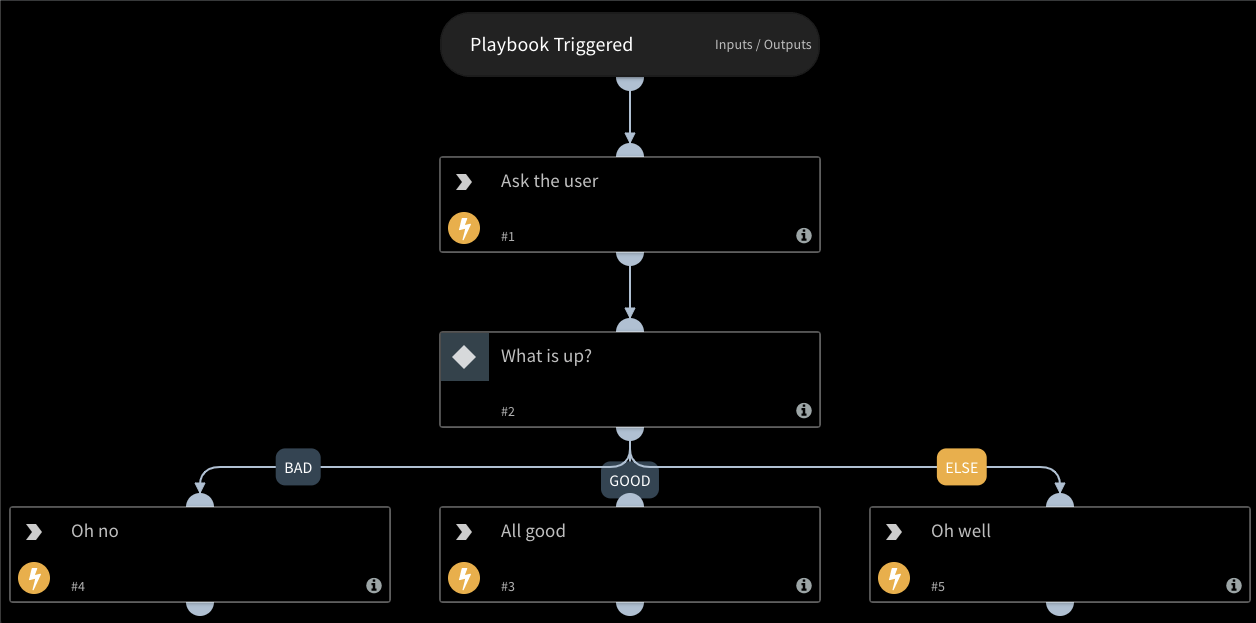SlackAskV2
This Script is part of the Slack Pack.#
Supported versions
Supported Cortex XSOAR versions: 5.5.0 and later.
Sends a message (question) to either user (in a direct message) or to a channel. The message includes predefined reply options. The response can also close a task (might be conditional) in a playbook.
SlackAskV2 was added to support the release of SlackV3 is only compatible with SlackV3.
Script Data#
| Name | Description |
|---|---|
| Script Type | python3 |
| Tags | slack |
| Demisto Version | 5.5.0 |
Use Case#
This automation allows you to ask users in Slack (including external to Cortex XSOAR) questions, have them respond and reflect the answer back to Cortex XSOAR.
Dependencies#
Requires an instance of the SlackV3 integration.
This script uses the following commands and scripts.
- send-notification
Inputs#
| Argument Name | Description |
|---|---|
| user | The Slack user to which to send the message. Can be either an email address or a Slack user name. |
| channel | The Slack channel to which to send the message. |
| message | The message to send to the user or channel. |
| option1 | The first reply option. The default is "Yes" with a green button. To change the color of the button, add the pound sign (#) followed by the name of the new color (green, red, or black). The default color is "green". For example, "Yes#green". Options cannot contain whitespaces. |
| option2 | The second reply option. The default is "No" with a red button. To change the button color, add the pound sign (#) followed by the name of the new color (green, red, or black). The default color is "red". For example, "No#red". Options cannot contain whitespaces. |
| task | The task to close with the reply. If empty, then no playbook tasks will be closed. |
| replyEntriesTag | Tag to add to email reply entries. |
| persistent | Indicates whether to use one-time entitlement or persistent entitlement. |
| responseType | How the user should respond to the question. |
| additionalOptions | A comma-separated list of additional options in the format of "option#color", for example, "maybe#red". The default color is "black". Options cannot contain whitespaces. |
| reply | The reply to send to the user. Use the templates {user} and {response} to incorporate these in the reply. (i.e. "Thank you {user}. You have answered {response}.") |
| lifetime | Time until the question expires. For example - 1 day. When it expires, a default response is sent. |
| defaultResponse | Default response in case the question expires. |
| slackInstance | The instance of SlackV3 this script should use. |
| slackVersion | The version of Slack to use. SlackV3 is configured by default. |
Outputs#
There are no outputs for this script.
Guide#
The automation is most useful in a playbook to determine the outcome of a conditional task - which will be one of the provided options.
It uses a mechanism that allows external users to respond in Cortex XSOAR (per investigation) with entitlement strings embedded within the message contents.

The automation can utilize the interactive capabilities of Slack to send a form with buttons -
this requires the external endpoint for interactive responses to be available for connection (See the SlackV3 integration documentation for more information).
You can also utilize threads instead, simply by specifying the responseType argument.
To use SlackAskV2 via playbook:
- Add the
SlackAskV2script to a playbook as a task. - In the
messageargument, specify the message to be sent. - Configure the response options by filling out the
option1andoption2arguments (default values are 'Yes' and 'No'). - Either a user or a channel_id or channel_name must be specified.
- In the
SlackAskV2task, pass a tag value to thetaskargument.
All other inputs are optional.
At some point at the playbook, after running SlackAskV2, add a manual conditional task, which holds up the playbook execution until the response is received from Slack.
The condition names must match the response options you passed in to SlackAskV2.
In order to tie the conditional task back to SlackAskV2, add the same tag from the fifth step to the conditional task (under the "Details" tab of the task). The conditional task will be marked as completed when a user responds to the SlackAskV2 form.
Notes#
- When using the
replyEntriesTagargument, thepersistentargument must be set toTrue. SlackAskV2will not work when run in the playbook debugger. This is because the debugger does not generate entitlements, since they must be tied to an investigation. Entitlements are needed to track the response.- Whitespaces are not supported in custom options and will not work. (i.e. setting a button to
I Agree)